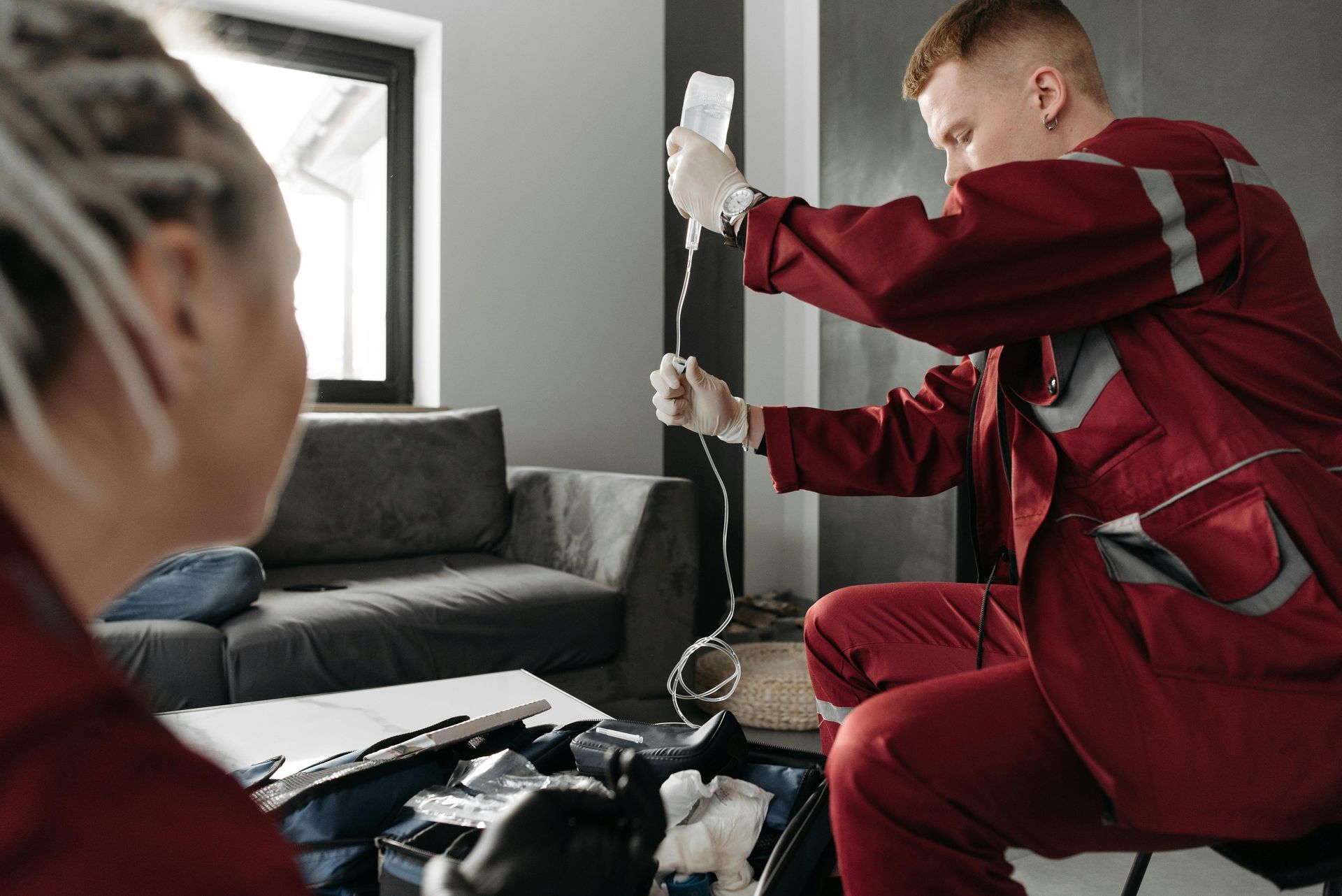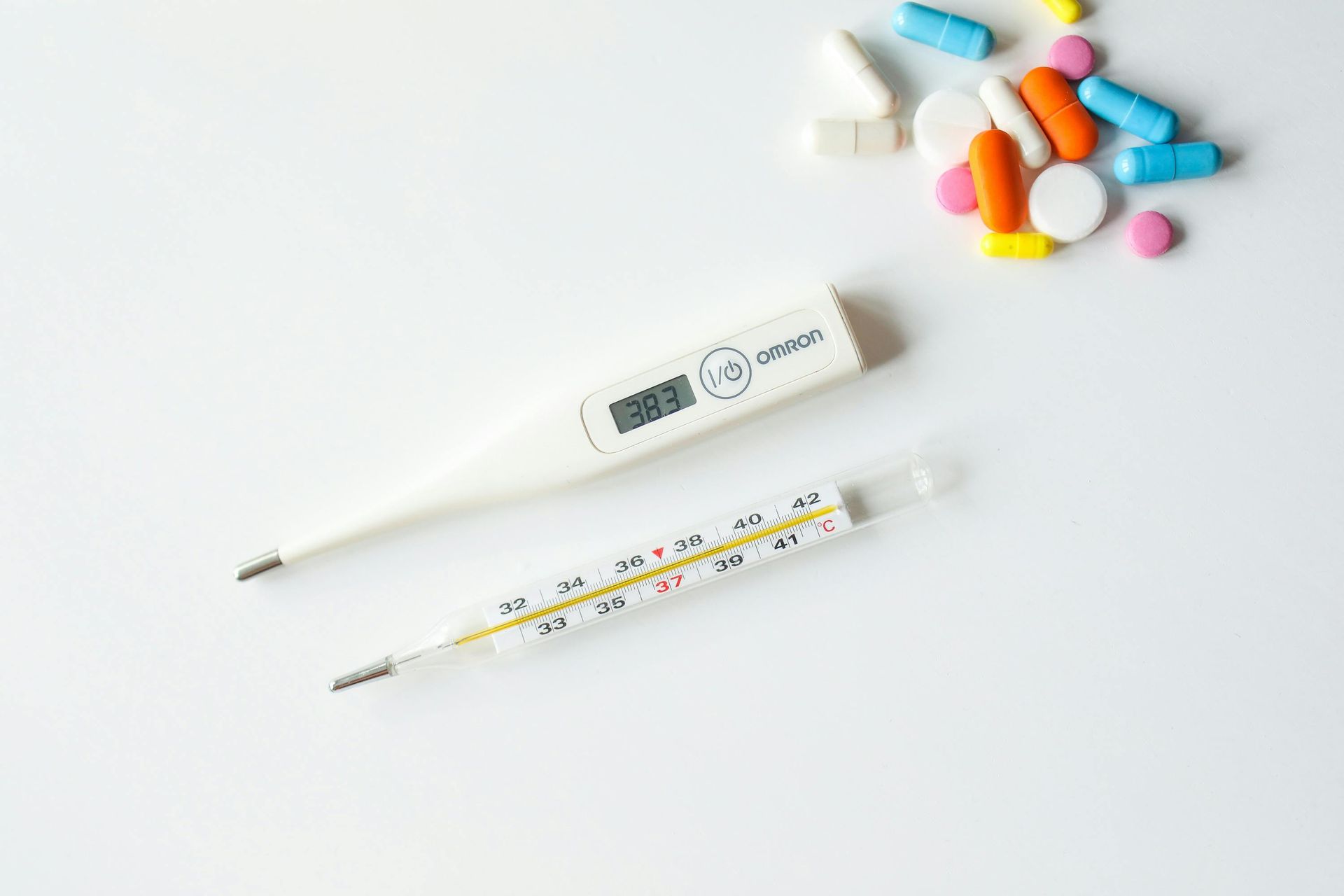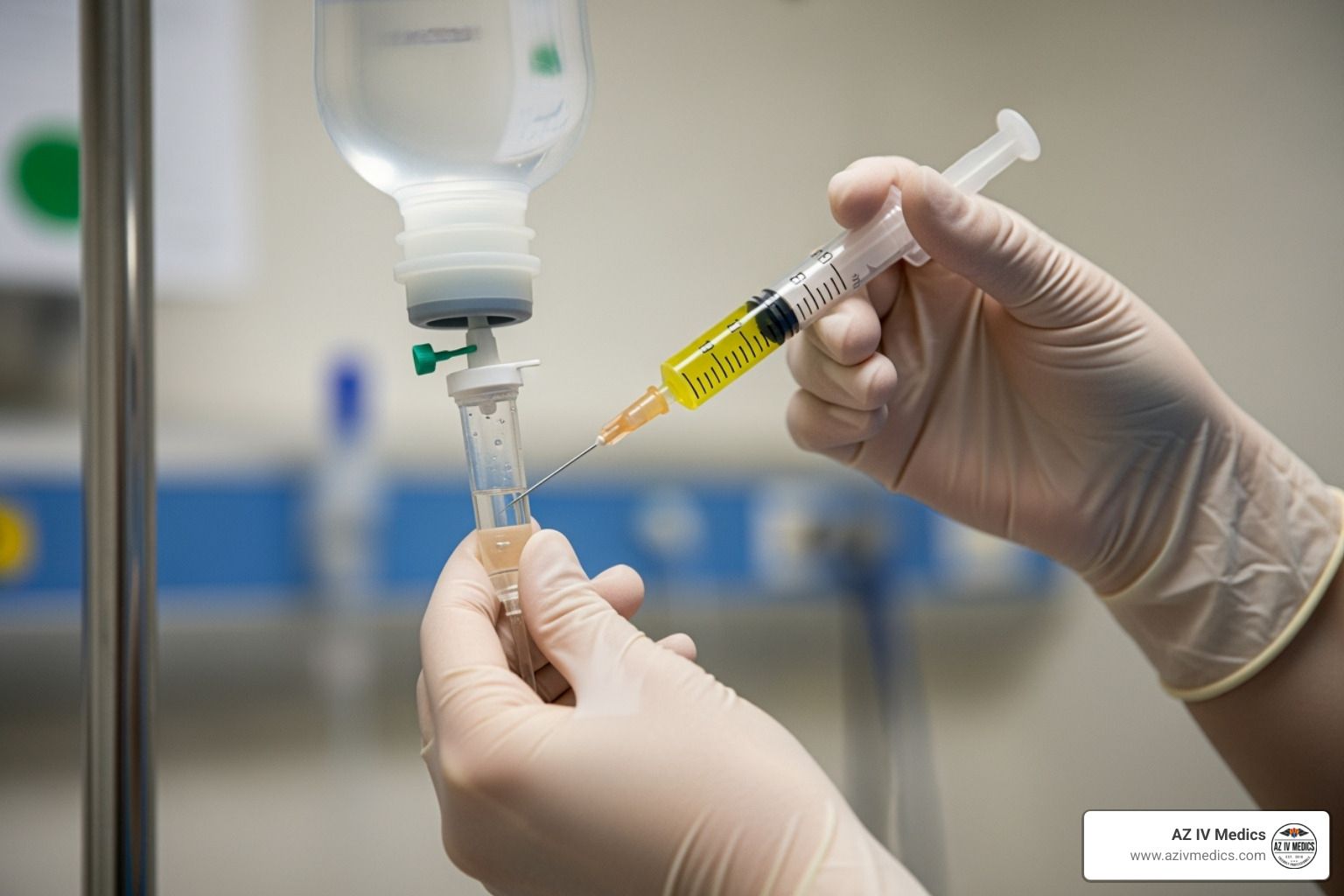Dehydration Fluid Replacement 101: Quench Your Curiosity

Medically reviewed by Micaela Strevay, FNP-C, PMHNP-BC
Table of Contents
Why Understanding Dehydration Fluid Replacement Matters

Dehydration fluid replacement is the medical process of restoring lost water and electrolytes to your body through oral or intravenous methods. Here's what you need to know:
Key Fluid Replacement Methods:
- Oral Rehydration Solutions (ORS) - Effective for 96% of mild to moderate dehydration cases
- Intravenous (IV) Fluids - Required for severe dehydration or when oral intake fails
- Crystalloid Solutions - Normal saline, lactated Ringer's for rapid volume restoration
- Maintenance Fluids - Ongoing hydration support using weight-based calculations
Your body loses fluids constantly through sweating, breathing, and normal body functions. In Arizona's desert climate, you can lose 1-2 liters of water daily through sweat alone. When fluid losses exceed intake, dehydration begins - sometimes with as little as 5% total fluid loss.
The symptoms start subtly: increased thirst, dark urine, fatigue. But dehydration can escalate quickly, especially in children, elderly adults, and anyone exposed to extreme heat. Understanding how to replace these lost fluids properly can mean the difference between quick recovery and serious complications.
This guide breaks down everything busy Arizona professionals and parents need to know about fluid replacement. We'll cover when oral solutions work, when IV therapy becomes necessary, and how to calculate proper fluid needs for different situations.
I'm Joseph Lopez AZIVM, and through my experience with mobile IV therapy services, I've seen how proper dehydration fluid replacement can rapidly restore health and energy to patients in their own homes. My work with AZ IV Medics has taught me that understanding these principles helps people make informed decisions about their hydration needs.

Understanding Dehydration: Causes, Signs, Diagnosis
Picture this: you're hiking Camelback Mountain on a typical Arizona summer day when that familiar thirst hits. By the time you feel thirsty, your body has already lost about 2% of its total fluid. That's the tricky thing about dehydration - it's sneaky, and in our desert climate, it can escalate faster than you'd expect.
Dehydration happens when your body loses more fluids than it takes in. Your body is roughly 60% water, and even a 5% loss triggers noticeable symptoms. In Arizona's relentless heat, where summer temperatures regularly soar past 105°F, this process moves at warp speed.
The science behind dehydration involves your body's remarkable but sometimes overwhelmed defense systems. When fluid levels drop, your body releases anti-diuretic hormone (ADH) to hold onto every drop of water it can. Your heart starts working overtime to maintain blood pressure, and your kidneys shift into conservation mode.
Heat stress tops the list of dehydration causes here in Arizona. Gastroenteritis with vomiting and diarrhea can drain your fluid reserves in hours. Diabetes cranks up urine production when blood sugar runs high, while diuretic medications increase fluid loss.
Fever adds another layer of complexity. Each degree of liftd temperature increases your fluid needs, which explains why that summer flu hits so much harder in our climate.
Early and Late Warning Signs
Your body sends clear signals when it needs fluid replacement. Increased thirst seems obvious, but it's not always reliable - especially in older adults whose thirst sensation diminishes with age.
Dry mouth and mucous membranes offer more dependable clues. Check inside your mouth - healthy mucous membranes should feel moist, not sticky or dry. Dark yellow urine provides another reliable indicator - it should be pale yellow, not deep amber.
Fatigue and dizziness often surprise people. That afternoon energy crash might signal your body's struggling with fluid balance. Decreased urination becomes noticeable when you're not visiting the bathroom at least 5-6 times daily.
The late warning signs demand immediate attention. Sunken eyes give faces a hollow appearance, and in infants, the soft spot on top of their head may appear sunken. Skin turgor - when you pinch skin and it doesn't bounce back quickly - indicates more serious fluid loss.
Rapid heart rate over 100 beats per minute at rest, low blood pressure , and confusion or irritability signal that dehydration has moved beyond the mild stage. These symptoms require professional medical attention.
Clinical Assessment Tools
Healthcare providers use proven assessment tools to determine severity and guide treatment decisions.
The NEWS score (National Early Warning Score) combines vital signs into a single number. A score of 5 or higher indicates potential hypovolemia requiring fluid administration.
For children, the Pediatric Clinical Dehydration Scale evaluates appearance, eyes, mucous membranes, and tears. This helps determine whether a child has mild dehydration (3-5% fluid loss), moderate dehydration (6-9%), or severe dehydration (10% or more).
Laboratory markers include liftd blood urea nitrogen (BUN) and creatinine, increased hematocrit, and electrolyte imbalances. Urine specific gravity above 1.020 indicates concentrated urine. Capillary refill time should be less than 2 seconds in well-hydrated individuals.
Dehydration Fluid Replacement Principles
Think of dehydration fluid replacement like fixing a leaky bucket. You need to stop the leak, figure out how much water you've lost, and then refill it properly. The human body works the same way - but the "water" we're replacing is much more complex than what comes from your tap.
Your body doesn't just lose plain water when you're dehydrated. You lose a carefully balanced mixture of water and electrolytes (especially sodium and potassium). This is why chugging plain water after a tough workout can actually make you feel worse.
The three-step approach starts with assessing your volume status. Are you in emergency mode needing immediate rescue? Are you replacing what you've already lost? Or are you just maintaining normal daily needs? Each situation requires a different strategy.
Oral rehydration works for 96% of mild to moderate dehydration cases. That means only 1 in 25 people actually need an IV. Your intestines are incredibly efficient at absorbing fluids when you give them the right mixture through glucose-sodium co-transport .
Isotonic fluids - those with sodium levels similar to your blood - are the gold standard for most situations. Hypotonic fluids can be dangerous because they can dilute your blood sodium to dangerous levels.
| Fluid Type | Best For | Sodium Content | When to Use |
|---|---|---|---|
| Crystalloids | Most situations | Matches blood levels | First-line treatment |
| Colloids | Severe blood loss | Variable | Hospital settings only |
Percent dehydration categories help determine treatment urgency. Mild dehydration (3-5% fluid loss) might just make you feel tired and thirsty. Moderate dehydration (6-9% loss) affects your heart rate and blood pressure. Severe dehydration (10% or more) is a medical emergency.
Dehydration Fluid Replacement in Mild & Moderate Cases
The World Health Organization's reduced-osmolarity formula contains exactly 75 mEq/L of sodium and has proven effectiveness through decades of research. You can learn more about oral rehydration therapy from WHO guidelines.
Making homemade ORS is straightforward: mix 1 teaspoon of salt and 6 teaspoons of sugar in 4 cups of clean water. It should taste no saltier than tears.
Small, frequent sips work better than chugging large amounts. For children, give about a teaspoon (5 mL) every 1-5 minutes . For mild cases, give 50 mL per kilogram of body weight over 4 hours. For moderate dehydration, double that to 100 mL per kilogram over 4 hours.
Zinc supplementation of 10-20 mg daily for 10-14 days helps reduce diarrhea duration. Continue breastfeeding throughout treatment - breast milk doesn't worsen diarrhea and actually speeds recovery.
Dehydration Fluid Replacement in Severe Cases
Severe dehydration requires immediate IV intervention . Phase 1 involves emergency resuscitation with a 20 mL/kg bolus of 0.9% sodium chloride over 10-20 minutes. For a 150-pound adult, that's about 1.4 liters delivered quickly.
Phase 2 shifts to deficit and maintenance replacement. Calculate the total deficit using: weight (kg) × % dehydration × 10 . Replace half of this deficit in the first 8 hours, plus normal maintenance needs. Replace the remaining deficit over the next 16 hours.
Serial reassessment every 2-4 hours includes checking urine output (should be at least 1 mL/kg/hour), heart rate, blood pressure, and mental status.
Rehydration Methods: Oral vs Intravenous
When it comes to dehydration fluid replacement , choosing between oral and intravenous methods isn't always straightforward. Think of it like choosing between a gentle rain and a fire hose - both deliver water, but the approach matters tremendously.
Oral rehydration works beautifully for most situations. It's safer than IV therapy, maintains normal gut function, and costs significantly less. You can do it at home without special equipment, and your body absorbs fluids in a more natural way.
IV therapy becomes necessary when dealing with severe dehydration (10% or more fluid loss), persistent vomiting, altered mental status, or dangerously low blood pressure. If you're vomiting every few minutes, IV therapy becomes a lifesaver - literally.
Sports drinks can help with mild dehydration, but dilute them with equal parts water to prevent stomach upset. For parents, continuing breastfeeding during treatment is crucial.

Setting up IV therapy requires specific equipment: appropriate IV catheter, IV tubing and pump, sterile saline, secure tape and dressing, plus tourniquet and alcohol swabs. The insertion follows strict sterile technique with careful monitoring for complications.
Crystalloid Drips Explained
Crystalloid solutions are the workhorses of IV fluid therapy. Normal saline (0.9% sodium chloride) contains 154 mEq/L of both sodium and chloride. It's isotonic to blood, making it first-line for volume resuscitation.
Lactated Ringer's solution offers a more balanced approach with 130 mEq/L sodium and 109 mEq/L chloride, plus lactate buffer. It more closely mimics your body's natural electrolyte composition.
D5W (5% dextrose in water) becomes hypotonic once your body metabolizes the glucose. It's used for maintenance in specific situations but never for volume resuscitation.
When to Choose Mobile IV Therapy
Mobile IV therapy offers unique advantages. Homebound patients who can't easily travel benefit enormously. Busy professionals choose mobile IV therapy for rapid recovery from dehydration when losing a day to feeling awful isn't an option.
Athletes use mobile IV therapy for pre-event hydration in Arizona's extreme heat. Travelers dealing with jet lag and dehydration find it incredibly convenient.
The benefits include convenience of home treatment, rapid symptom relief within an hour, customized fluid combinations, and no waiting room exposure. IV hydration can be up to three times faster than oral rehydration for symptom relief.
Calculating Fluid Needs & Monitoring
Getting the math right matters when it comes to dehydration fluid replacement . Healthcare providers use proven formulas that take the guesswork out of fluid calculations.
For children, we use the 4-2-1 rule for hourly maintenance . Give 4 mL per kilogram per hour for the first 10 kg of body weight, then 2 mL per kilogram per hour for the next 10 kg, and 1 mL per kilogram per hour for every kilogram above 20 kg.
Adults need about 35 mL per kilogram per day for maintenance - roughly 2,500 mL for a 70 kg adult. Arizona's desert heat can easily double these requirements.

Deficit calculations help determine how much fluid someone has lost. The formula: weight in kilograms multiplied by percentage of dehydration multiplied by 10. A 15 kg child with 8% dehydration has lost 1,200 mL that needs replacing.
Monitoring parameters include daily weights (the gold standard), urine output goals (adults need 1 mL/kg/hour, children need 1.5 mL/kg/hour), and vital signs every 4-6 hours during treatment.
Adjustments for Special Populations
Elderly patients typically receive about two-thirds of calculated maintenance fluids due to heart conditions that make fluid overload dangerous. Patients with kidney disease require careful fluid restriction and electrolyte monitoring.
Athletes exercising in extreme heat need aggressive replacement - someone exercising vigorously in 100°F weather can lose 2-3 liters per hour through sweat. The key is frequent reassessment and adjusting treatment based on individual response.
Risks, Complications & Safety Tips
While dehydration fluid replacement can be life-saving, understanding potential complications helps you recognize warning signs and seek appropriate care.
Hyponatremia occurs when sodium levels drop too low, often from giving too much free water. This creates brain cell swelling, causing confusion, headaches, or seizures. Hypernatremia represents too much sodium, also affecting brain function.
Cerebral edema represents one of the most feared complications. When fluids are replaced too quickly, especially in children, brain swelling can occur. This is why gradual correction and careful monitoring are essential.
Fluid overload becomes a concern when the body receives more fluid than it can handle. Early signs include shortness of breath, swelling in legs or face, and rapid weight gain. People with heart failure face higher risks.
IV-related complications include infection at the insertion site , infiltration when IV fluid leaks into surrounding tissue, and phlebitis involving vein inflammation.

Preventing Errors
Healthcare providers follow the "Four Rights" to prevent dangerous mistakes: right drug, right dose, right duration, and right patient consideration.
Critical safety rules include never using hypotonic maintenance fluids in hospitalized children, avoiding rapid correction of chronic electrolyte problems, and monitoring for fluid overload signs. Most hospitalized children need less than full maintenance fluids because illness causes water retention.
The safest approach involves using pre-mixed solutions and establishing clear monitoring protocols including regular weight checks and laboratory testing when indicated. Understanding these risks means approaching treatment with appropriate caution and professional oversight.
Frequently Asked Questions about Dehydration Fluid Replacement
What's the fastest way to rehydrate after intense exercise?
When you've just finished an intense workout in Arizona's blazing heat, your body is crying out for fluids. IV therapy delivers the fastest results - you'll typically feel better within 30-60 minutes because the fluids go directly into your bloodstream.
But here's the thing: oral rehydration works perfectly well for most situations and is much more convenient. The key is doing it right. Drink 24 ounces of fluid for every pound you lost during exercise. Yes, that means weighing yourself before and after your workout!
In Arizona's desert climate, you might lose 2-3 liters during vigorous activity. That's a lot of fluid to replace. The secret is starting dehydration fluid replacement before you feel thirsty - thirst is actually a late sign that you're already behind on hydration.
Choose drinks with electrolytes rather than plain water. Your body needs to replace the sodium and potassium you've sweated out, not just the water. Sports drinks work, but they're often too concentrated - dilute them with equal parts water for better absorption.
How do I know if my child needs IV fluids instead of ORS?
As a parent, this question probably keeps you up at night when your little one is sick. The good news is that oral rehydration succeeds in 96% of cases when done properly. But there are some red flags that mean it's time to seek medical attention for IV therapy.
Watch for these warning signs: persistent vomiting that prevents your child from keeping down even small sips, signs of severe dehydration like sunken eyes or no tears when crying, and extreme lethargy or confusion. If your child has lost more than 10% of their body weight or shows no improvement after 4-6 hours of proper oral rehydration, it's time for professional help.
Here's what many parents don't realize: even if your child vomits some of the oral rehydration solution, most of it still gets absorbed. Don't give up too quickly. Give small, frequent sips - about a teaspoon every few minutes for young children.
Trust your parental instincts. If something feels seriously wrong, don't hesitate to seek medical care. Dehydration fluid replacement through IV therapy can be life-saving when oral methods aren't working.
Can I overhydrate and cause harm with fluids?
This might surprise you, but yes - you absolutely can have too much of a good thing when it comes to fluids. Overhydration can be dangerous and sometimes even life-threatening.
Water intoxication causes something called hyponatremia, where your blood sodium levels drop dangerously low. This leads to brain swelling, and the symptoms are scary: nausea, headache, confusion, and in severe cases, seizures or even death.
The risk is highest when you drink large amounts of plain water without electrolytes. Your body needs the right balance of water and sodium to function properly. This is why marathon runners who drink only water during long races sometimes collapse - they've diluted their blood sodium to dangerous levels.
Signs of overhydration include nausea, headache, confusion, and swelling in your hands and feet. If you're replacing fluids after illness or intense exercise, always include electrolytes in your dehydration fluid replacement strategy.
The good news is that overhydration is much less common than dehydration, especially in Arizona's climate. But it's important to know that balance is key - your body needs the right amount of fluids with the right electrolyte content to function at its best.
Conclusion & Next Steps
Taking control of your hydration needs starts with understanding dehydration fluid replacement - and now you have the knowledge to make smart decisions when dehydration strikes. Whether you're dealing with Arizona's brutal summer heat, caring for a sick child, or pushing through an intense workout, the same core principles apply every time.
Think of proper hydration like maintaining your car - regular maintenance prevents breakdowns, but when problems arise, you need the right tools and knowledge to fix them quickly. Oral rehydration therapy works beautifully for 96% of mild to moderate cases , while IV therapy steps in when your body needs faster, more direct intervention.
The most important thing to remember? Don't wait until you're desperately thirsty. Your body is already behind on fluids by then. Instead, make hydration a daily habit - check your urine color each morning (pale yellow is perfect), drink fluids throughout the day, and always include electrolytes when you're sweating heavily.
Watch for these red flags that mean it's time to seek immediate medical help: persistent vomiting that prevents keeping fluids down, confusion or altered mental status, a resting heart rate over 100 beats per minute, or any signs of severe dehydration in children like sunken eyes or extreme lethargy.
Here in Arizona, where our desert climate can dehydrate you faster than you'd expect, having a backup plan makes sense. When oral rehydration isn't cutting it - maybe you're dealing with a nasty stomach bug, recovering from a night out, or just need rapid relief from heat exhaustion - mobile IV therapy brings hospital-quality hydration right to your door.
We've eliminated the hassle of driving to urgent care, sitting in waiting rooms, and dealing with parking fees. Instead, you get professional IV hydration in your own comfortable space, whether that's your home, office, or hotel room.
Proper hydration isn't just about chugging water. It's about maintaining that delicate balance of fluids and electrolytes that keeps every system in your body running smoothly. Whether you choose the oral route or need IV support, understanding these principles ensures you're treating dehydration safely and effectively.
Your body works hard to keep you healthy - especially in our challenging desert environment. Give it the hydration support it deserves, and you'll feel the difference in your energy, focus, and overall well-being. Stay hydrated, stay healthy, and know that professional help is just a phone call away when you need it most.





